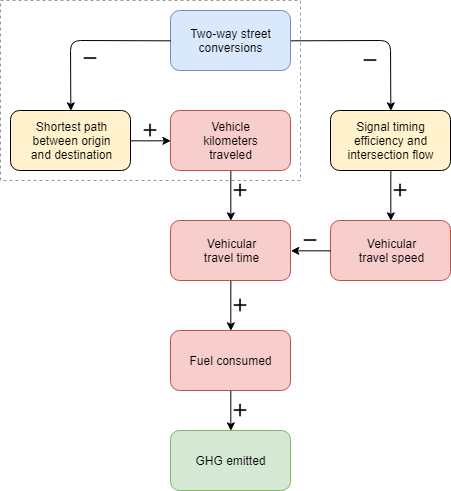I have a new article out now in the Journal of Planning Education and Research with Billy Riggs, in which we examine how two-way street conversions impact street network efficiency. Most of the efficiency literature looks at the benefits of one-way streets for signalization and vehicular throughput. We took a different approach, considering how one-way streets inherently increase travel distances.
 We found that two-way street conversions (all else equal) would allow for significantly shorter average travel distances: San Francisco’s as-is network’s average intra-city trip is about 1.7% longer than it could be if it were all two-way streets, corresponding to 27 million kilometers of annual surplus travel just for intra-city trips. From the abstract:
We found that two-way street conversions (all else equal) would allow for significantly shorter average travel distances: San Francisco’s as-is network’s average intra-city trip is about 1.7% longer than it could be if it were all two-way streets, corresponding to 27 million kilometers of annual surplus travel just for intra-city trips. From the abstract:
Planning scholars have identified economic, safety, and social benefits of converting one-way streets to two-way. Less is known about how conversions could impact vehicular distances traveled—of growing relevance in an era of fleet automation, electrification, and ride-hailing. We simulate such a conversion in San Francisco, California. We find that its current street network’s average intra-city trip is ~1.7 percent longer than it would be with all two-way streets, corresponding to 27 million kilometers of annual surplus travel. As transportation technologies evolve, planners must consider different facets of network efficiency to align local policy and street design with sustainability and other societal goals.
As cities move away from LOS, there are network efficiency arguments to be made for two-way street conversions. While conversions have financial and political costs, they may help cities better prepare for sustainable future mobility by balancing various social benefits with network efficiency. For more, check out the article.
One reply on “Two-Way Streets and Network Efficiency”
[…] questioning some of the received wisdom about one-way streets and efficiency. This builds on our recent research published in JPER modeling vehicle distance traveled before and after hypothetical one-way to […]